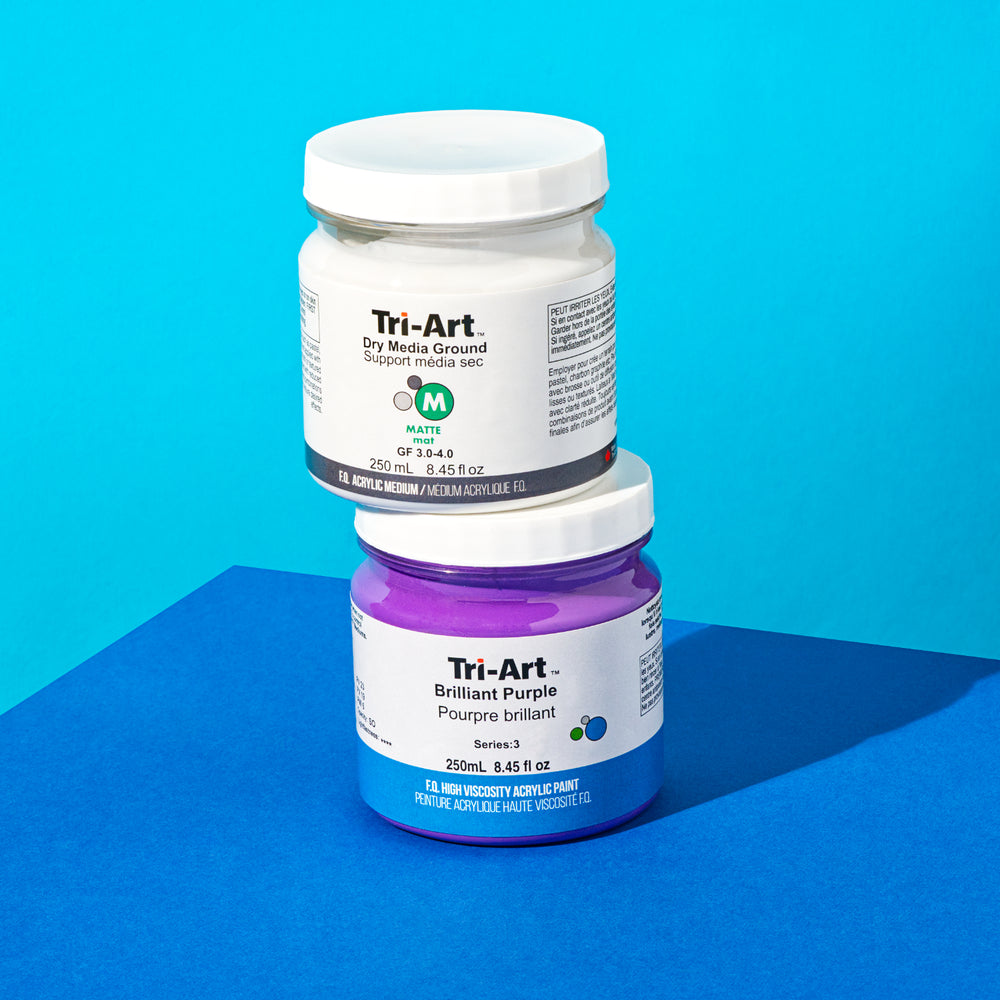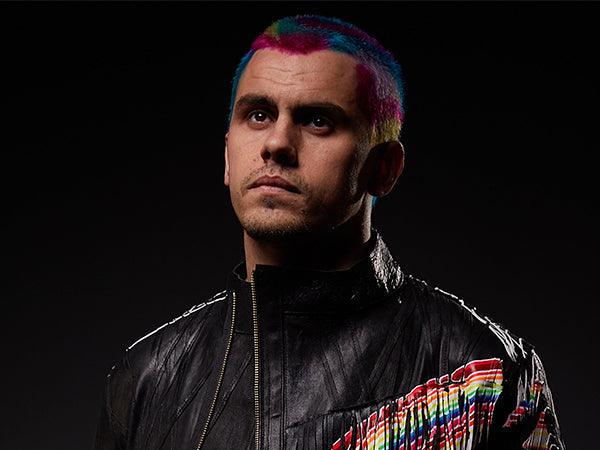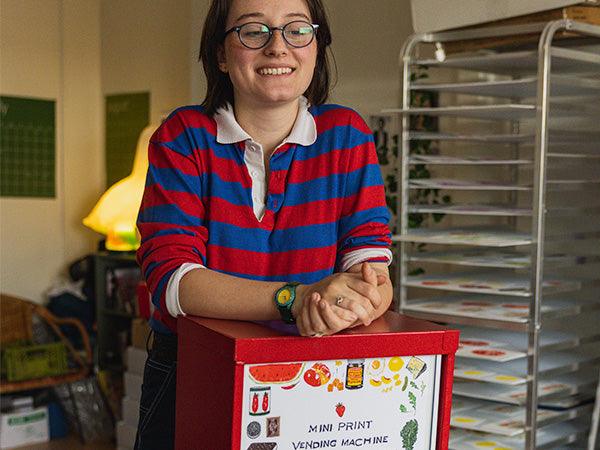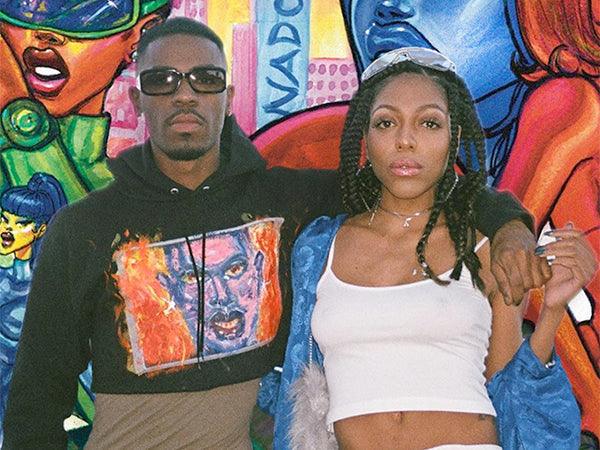
When you decided to pursue art, what challenges did you face and how did you push forward? What would you say to your younger self?
"When I started my career I believed in myself, but it's so important to continue to hold that belief. I would tell my younger self to not look for so much external validation. Whether that be through gallery representation, having artwork in fairs or prestigious collections, or through likes or follows. Those quantifiable numbers aren’t measurements of one's success.
I believe that success is really just happiness and happiness is not found through comparison. That's actually the quickest way to unhappiness. You have to trust the process, stick with the course and believe in yourself. I've done that, but I've wavered. If I could've just stayed firm to that belief, my younger self perhaps would have enjoyed the pathway a little bit more to get to where I am today."


You are an excellent spokesperson and positive role model for mental health. What is the meaning of the Fake Art movement and how it relates to wellbeing?
"I’m an advocate for positivity and anti-cyberbullying.
The Fake Art movement is about taking something that somebody said negatively and flipping it. Negativity or hate doesn't go away when we stop talking about it. It almost grows in the shadows, like a creepy infestation of mold. If you don't blast it with light or clean it up it's going to grow, it's going to fester, and it's going to rear its nasty head in one way or another. So by talking about it, we bring it to light and state that we don't tolerate this.
If someone looks at my art and says, for example; “A five-year-old could do this.” Well, yea - anyone can do it. I change the emphasis on the words - anyone can do it. That's a positive thing and I want them to know they can, I would encourage them to.
I think a lot of the time people question value. They don't think about how for over a decade I have worked on this process, or all of the material, time, trials and errors. They just see a 30-second clip. If you look at other industries, like sports, you wouldn't question a baseball player for hitting a home run. They practiced their whole life to do that. A ballerina doing a pirouette might look easy - but that's because they made it look easy.
Sometimes negative comments stem from frustration or angst that an individual has found in their own life and is projecting. Often the case has to do with their parents or somebody in their education system, or a lack thereof. I'm very fortunate and grateful that I had a supportive mother, father and education system. As someone who is neurodivergent in having dyslexia, I have strengths and weaknesses. So, I was encouraged to go in the art direction. I really embraced that with a lot of support. But, not everyone has a system that supports their differences and abilities.
I try to put myself in their shoes, rather than getting mad or upset. I've had people come around, you know, at first being a naysayer. Later, sometimes those individuals start to paint. Those are my little victories; when I feel like somebody who was unable to see the passion or the beauty something is then able to change their mind."


How does social media influence you and what you create?
"I think it's really important to take advantage of the opportunity social media allows you. So, I've been pretty active on social media - but lately, I've been trying to balance life a little more. During the pandemic, for about two years I was going live almost every day. Since I didn't strictly go the gallery route, social media is how I stay connected to my audience.
But, platforms change. I was one of the first artists on Tik Tok, but now you'll see Instagram Reels is just like Tik Tok and YouTube Shorts is just like Tik Tok. It's been this whole movement and I’ve been happy to be a part of that trend.
I love to be able to share my process. That's what my videos are really; a welcome to my world. They can be insightful for people and help them to get into a creative space. Being candid and honest can be refreshing because sometimes platforms only present a polished end result. I like to show some of the struggles when it doesn't work out - because that's real, too. Authenticity is refreshing on these apps while you're bombarded by a highlight reel of the best of the best. It’s nice to be able to see mistakes, too. I’m hoping it gives people the courage to share more.
I've definitely had a parallel growth and I don't know what my art would look like without social media. My art is very sympathetic to the platform. It is very visually stimulating and satisfying to watch. So I think that it translates well - but it's also changed my process in that I can turn on my phone and have hundreds of thousands of people in my studio."

What is your proudest moment in your art career?
"The moments come and go, but I think what remains is the practice and the ritual of just showing up. It sounds very simple, but art is almost spiritual or meditative.
I try to put this hat on and a presentation of positivity and whatnot. Though, I am not always positive and I'm not always my best self. Art has been something that has been a really compelling, healing and transformative aspect of my life.
Of course, I've had breakthroughs, big moments, and techniques I've been working on for years. Prestigious collectors might pick up a large piece or I might get to perform in front of a large audience. But I think to this day, the fact that I've continued to explore is what's most powerful."


"So that reminds me why I'm doing it - for love. Not necessarily the love between two people but love as a frequency or a vibration, like a collective project."
Was there a time when you felt like you had a significant impact on someone through your work? How did that feel?
“I don't hear about all of the instances. Sometimes people collect my art and I never hear from them again. Though, time and time again I've had people reach out to me and let me know how the art has affected them. It's helped people with incredible things - like getting through traumas. One couple that had a stillborn child told me that the artwork had helped them deal with the grieving process. I've also had a friend who used to be in the military and has PTSD. He let me know that being around art has helped him on his journey.
Some stories are too private to share, but seeing how art has affected people’s day-to-day lives gives me the courage to keep on going. Sometimes, in the comments people will say that they struggle with anxiety, depression, or trauma and my artwork has helped them - that blows my mind.
If one person says something, I'm sure others are out there. So that reminds me why I'm doing it - for love. Not necessarily the love between two people but love as a frequency or a vibration, like a collective project. Rather than furthering our creativity or our love for one another in an insular or capsule alone, we're going to do it together.
Sometimes that turns into a mantra and almost loses its meaning. I begin to wonder what my work is really about. Then every once in a while, I get positive feedback. When that comes externally, it redefines perspective and reminds me of the purpose.
When I make a piece, it's almost half completed. I feel very connected to my audience, so by sharing it, it almost reaches its conclusion. Like a prompt, the audience engages with it, whether it’s through comments, likes, follows or purchasing it. Whatever way they engage with it, that conversation begins."


You often describe your work as something that is natural and not in your full control. From this perspective, can you describe your process?
"I'm fascinated by natural phenomena. centrifugal motion is my main focus. To do this, I use a bicycle which is cannibalized to spin my paintings. I also use pendulums and fluid dynamics; it's almost like science at play.
I find that whenever I try to control it, it loses that je ne sais quoi. It's when I'm able to let go and make mistakes that success happens. It's a little bit out of control with the fact that I've relinquished my artist's hand; you won't find a paintbrush, paint stroke. Even my signature is on the back of the painting.
One of my techniques mistakingly happened when I flicked the paint and it twirled and spun in the air. I’ve also created what I call “Unicorns”, because they look like little Nautilus horns, where I fold the paint in the air. Another technique that was created I call the “Fold”. In this technique I can't even see what I'm doing - it's just blind trust. I've even done whole presentations blindfolded.
While there's physically letting go, there's also a spiritual aspect. I often do breathing exercises and meditate every day. In a way, the painting acts as a form of meditation. It's almost out of the body where it's not really about me and I'm not asserting my ego. It's just nature's beauty. I'm just trying to capture a little bit of its magic.
If I do the right thing, the paintings almost feel like they are moving a little bit. The motion carries through them and lets go of stillness. We want to hold on to the things we love and things that we care about. But when we let things free they become cathartic."


"It's been a natural progression and I love the large scale of the work, but it's physically demanding. Even just constructing it; the canvas, the rigging, the large volumes of paint. There might be a five gallon pale, and sometimes I'll go through three or four of those. So it's like I'm pouring 30 gallons of paint. Just moving that paint around is a rigorous process.
I've done a few pieces where for dramatic effect I'll paint them and I'll destroy them. Those are instances where it's just a performance. It's how I can talk about this economy of art. It brings an urgency to the experience. What was just there for your viewing pleasure now ceases to exist. It's gone now as everything is fleeting. Sometimes the performance takes over, intentionally or unintentionally. Maybe I'm working through something or I'm frustrated or I'm angry or sad or I'm depressed.
In the trapeze, it is scary to be hanging upside down. But, on the other side of fear is creativity. If you are scared, it could just be that you care and you're nervous about something, like stage fright. That could just be because you care so much and you don't want to mess up. Though, sometimes fear is stifling. When you're most creative you feel like you can play. You feel playful because you're not being judged by somebody else or yourself. In your head, creativity is where fear ceases to exist. Creativity is just on the other side of fear, it's right there. They're like neighbours.
So far the Human Trapeze has given me my most viral video, and with that comes the most hate. However, this also tells me that I'm going in the right direction. Again, those are the people that are maybe still on the side of fear. They're not ready for creativity yet, but we're getting closer.
Keeping that childlike wonder alive is a constant pursuit. We have it when we're young and as life goes on we sort of develop these more rigid ways of thinking, rationalizing, stepping outside of ourselves and fitting inside norms and conventions. So the trapeze is a way for me to get back into it. It's just an opening, and now I need a taller ceiling."


Do you separate art and performance, or are they quintessential to each other processes and techniques like the Human Trapeze?
"I think that performance art could be a standalone thing. Personally, that's why I do it. I love the process and I love that I get to share the process through video. The result is almost like a byproduct. The paintings that are covered in paint turn into artwork, the shoes get turned into artwork, the canvas on the floor on the inside of the arena gets turned into artwork. Everything that the paint touches turns into art and is sold. So in that way I've definitely made it very economical.
However, I love the process. I think that's really where the art takes place the most for me. Again, it's a group project; it's engaging with the audience. But, I was working with the trapeze for so long and I found myself a little bit absent-mindedly going through the motions. I said to myself, you know, I've done it so many times, but I felt like I was losing touch and I wanted to get back into the zone.
What better way to get back into the zone than to literally become the trapeze that I've been swinging all this time. To become the paintbrush, essentially."

So, what's next? What are you most looking forward to in your upcoming work?
"The next show I'm excited for is in Brooklyn, New York at TwoFortyThirty. (Address: 240 W 30th St 4th Floor, New York, NY 10001, United States). I've shown in New York before and I'm happy that I have the opportunity to show there again. It's kind of the center of the universe in a way.
I've also been working a lot in the VR space recently too, which I'm gonna be debuting a new component of soon. It has been a difficult journey with cryptocurrency, the market crash, and the pandemic. Right now people just want to get out and see real faces. Screen time is not a priority and I think that the audience isn't quite there yet. But I’m very excited to share my VR Gallery, which is a testament to my legacy. It's got all of my greatest hits which you can experience to scale, which is interesting because I love accessibility.
You can just use the gyroscopic function of the phone. It's like a window that you can kinda look through with your phone. You can play with the paint and the trapezes so that it's a way people can really engage with the work. It's for everybody and anyone can do it.
A woman from Ottawa had told me she's a disabled artist. She said that she can't go to a physical gallery, it's not practical for her with her immobility. But with this, she was able to show up. We were able to talk and move around and engage in a physical space where otherwise she couldn't even have access to. So right there, that made it all worth it.
One person is all it takes, to make it completely worth it."





